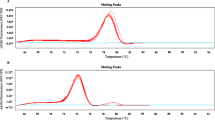Abstract
Agricultural practices, such as spreading liquid manure or the utilisation of land as animal pastures, can result in faecal contamination of water resources. Rhodococcus coprophilus is used in microbial source tracking to indicate animal faecal contamination in water. Methods previously described for detecting of R. coprophilus in water were neither sensitive nor specific. Therefore, the aim of this study was to design and validate a new quantitative polymerase chain reaction (qPCR) to improve the detection of R. coprophilus in water. The new PCR assay was based on the R. coprophilus 16S rRNA gene. The validation showed that the new approach was specific and sensitive for deoxyribunucleic acid from target host species. Compared with other PCR assays tested in this study, the detection limit of the new qPCR was between 1 and 3 log lower. The method, including a filtration step, was further validated and successfully used in a field investigation in Switzerland. Our work demonstrated that the new detection method is sensitive and robust to detect R. coprophilus in surface and spring water. Compared with PCR assays that are available in the literature or to the culture-dependent method, the new molecular approach improves the detection of R. coprophilus.
Similar content being viewed by others
References
Anon (2006) Swiss Accreditation Service: Leitfaden zur Validierung mikrobiologischer Prüfverfahren und zur Abschätzung der Messunsicherheit im Bereich Lebensmittel- und Umweltmikrobiologie. Mitt Lebensm Hyg 97:73–106
Bustin SA, Benes V, Garson JA, Hellemans J, Huggett J, Kubista M, Mueller R, Nolan T, Pfaffl MW, Shipley GL, Vandesompele J, Wittwer CT (2009) The MIQE guidelines: minimum information for publication of quantitative real-time PCR experiments. Clin Chem 55:611–622
Gavini F, Pourcher AM, Neut C, Monget D, Romond C, Oger C, Izard D (1991) Phenotypic differentiation of bifidobacteria of human and animal origins. Int J Syst Bacteriol 41:548–557
Havelaar AH, Pot-Hogeboom WM, Furuse K, Pot R, Hormann MP (1990) F-specific RNA bacteriophages and sensitive host strains in faeces and wastewater of human and animal origin. J Appl Bacteriol 69:30–37
Jagals P, Grabow WOK, de Villiers JC (1995) Evaluation of indicators for assessment of human and animal faecal pollution of surface run-off. Water Sci Technol 31:235–241
Layton A, McKay L, Williams D, Garrett V, Gentry R, Sayler G (2006) Development of Bacteroides 16S rRNA gene TaqMan-based real-time PCR assays for estimation of total, human, and bovine fecal pollution in water. Appl Environ Microbiol 72:4214–4224
Long SC, Shafer E, Arango C, Siraco D (2003) Evaluation of three source tracking indicator organisms for watershed management. J Water SRT Aqua 52:565–575
Mara DD, Oragui JI (1981) Occurrence of Rhodococcus coprophilus and associated actinomycetes in feces, sewage, and freshwater. Appl Environ Microbiol 42:1037–1042
Mara DD, Oragui JI (1983) Sorbitol-fermenting bifidobacteria as specific indicators of human faecal pollution. J Appl Bacteriol 55:349–357
Meays CL, Broersma K, Nordin R, Mazumder A (2004) Source tracking fecal bacteria in water: a critical review of current methods. J Environ Manage 73:71–79
Mendez J, Audicana A, Isern A, Llaneza J, Moreno B, Tarancon ML, Jofre J, Lucena F (2004) Standardised evaluation of the performance of a simple membrane filtration-elution method to concentrate bacteriophages from drinking water. J Virol Methods 117:19–25
Oragui JI, Mara DD (1983) Investigation of the survival characteristics of Rhodococcus coprophilus and certain fecal indicator bacteria. Appl Environ Microbiol 46:356–360
Reischer GH, Kasper DC, Steinborn R, Mach RL, Farnleitner AH (2006) Quantitative PCR method for sensitive detection of ruminant fecal pollution in freshwater and evaluation of this method in alpine karstic regions. Appl Environ Microbiol 72:5610–5614
Rowbotham TJ, Cross T (1977a) Ecology of Rhodococcus coprophilus and associated actionomycetes in fresh water and agricultural habitats. J Gen Microbiol 100:231–240
Rowbotham TJ, Cross T (1977b) Rhodococcus coprophilus sp. nov.:an aerobic nocardioform actinomycete belonging to the ‘rhodochrous’ complex. J Gen Microbiol 100:123–138
Savichtcheva O, Okabe S (2006) Alternative indicators of fecal pollution: relations with pathogens and conventional indicators, current methodologies for direct pathogen monitoring and future application perspectives. Water Res 40:2463–2476
Savill MG, Murray SR, Scholes P, Maas EW, McCormick RE, Moore EB, Gilpin BJ (2001) Application of polymerase chain reaction (PCR) and TaqMan PCR techniques to the detection and identification of Rhodococcus coprophilus in faecal samples. J Microbiol Methods 47:355–368
Scott TM, Rose JB, Jenkins TM, Farrah SR, Lukasik J (2002) Microbial source tracking: current methodology and future directions. Appl Environ Microbiol 68:5796–5803
Shanks OC, Santo Domingo JW, Lamendella R, Kelty CA, Graham JE (2006) Competitive metagenomic DNA hybridization identifies host-specific microbial genetic markers in cow fecal samples. Appl Environ Microbiol 72:4054–4060
Shanks OC, Atikovic E, Blackwood AD, Lu J, Noble RT, Domingo JS, Seifring S, Sivaganesan M, Haugland RA (2008) Quantitative PCR for detection and enumeration of genetic markers of bovine fecal pollution. Appl Environ Microbiol 74:745–752
Shanks OC, White K, Kelty CA, Hayes S, Sivaganesan M, Jenkins M, Varma M, Haugland RA (2010) Performance assessment PCR-based assays targeting bacteroidales genetic markers of bovine fecal pollution. Appl Environ Microbiol 76:1359–1366
Sinton LW, Finlay RK, Hannah DJ (1998) Distinguishing human from animal faecal contamination in water: a review. N Z J Mar Freshwater Res 32:323–348
Acknowledgements
The present study was conducted in the laboratories of the Consumer Protection Directorate of the Federal Office of Public Health (FOPH; 3003 Bern, Switzerland) and was financed by research grant FOPH/07.006623. The authors would like to thank Dr. Dominik Moor (FOPH) for proofreading the article.
Author information
Authors and Affiliations
Corresponding author
Electronic supplementary material
Below is the link to the electronic supplementary material.
ESM 1
(PDF 17 kb)
Rights and permissions
About this article
Cite this article
Wicki, M., Auckenthaler, A., Felleisen, R. et al. Improved detection of Rhodococcus coprophilus with a new quantitative PCR assay. Appl Microbiol Biotechnol 93, 2161–2169 (2012). https://doi.org/10.1007/s00253-012-3888-4
Received:
Revised:
Accepted:
Published:
Issue Date:
DOI: https://doi.org/10.1007/s00253-012-3888-4




